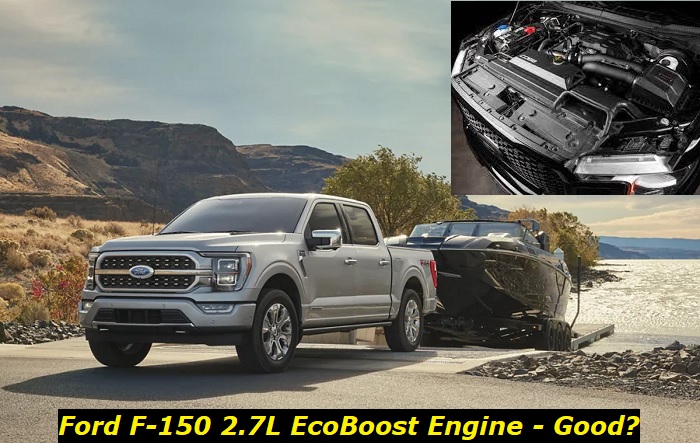In the current model year, the Ford F-150 is presented with a whole bunch of different engines. There is something for anyone, we would say. But still, one of the most popular choices is the good old 2.7L EcoBoost engine that has been used in this truck for a couple of generations and several years now.
Today, we'll tell you more about the 2.7L Turbo engine in the Ford F-150 and its common issues, main advantages, and also some key features you should know. We've checked out hundreds of reviews and have also spoken to car mechanics and asked their opinion about these engines. This will be fun!

Key features and my opinion about the engine
- Production years:2015-now
- Average lifespan of 2.7L V6 EcoBoost:190,000-240,000 miles
- Fuel supply type:direct injection (later combined direct + port injection)
- Power range:315-330 hp
- Fuel efficiency:average
- Engine block material:cast-iron
- Engine reliability score:medium
- The most common problems:valvetrain problems, issues with electronics, oil consumption, power loss.
Key facts about the 2.7L EcoBoost engine in the F-150
So, the current version of the 2.7L EcoBoost Nano engine was introduced in 2018 and hasn't been modified a lot since then. It has only been used in the Ford F-150 and also in the Ford Bronco while the first-generation 2.7L EcoBoost engines were also used in the Edge, Fusion Sport, and also in a lot of Lincoln models.
The second-gen 2.7L EcoBoost engine is pretty cool in terms of power-consumption ratio. Also, it works smoothly and doesn't get on your nerves with a lot of vibration or noise. This is one of the engines engineered by Ford that got a lot of positive reviews from owners and professionals and this makes the engine worth your attention.
Here's what you should know about it:
- the 2.7L EcoBoost engine in the new Ford F-150 truck offers 325 horsepower and 400 lb-ft of torque - not bad for the relatively small V6 powerplant;
- the engine block is made of compacted graphite iron making it durable and very lightweight;
- direct fuel injection is not alone anymore in this generation, Ford added port fuel injection to help the engine avoid carbon buildup;
- also, Ford added EGR or exhaust gas recirculation system which is good for ecology protectors but bad for the wallet of the owner in the long run;
- the timing system is driven by two chains - they are not eternal and will need replacement at 100,000 miles or once they start rattling;
- the twin-turbo system was also modified and got several important advantages over the older generation of the engine, it became less problematic;
- the new oil pump is electronically controlled to modulate oil flow and this may be the reason for concerns about its longevity;
- the vehicle shows 20 MPG in the city and up to 26 MPG on highways which is not bad if you compare it with other full-size trucks;
- the engine is mated to the 10-speed automatic transmission as any other engine in the new F-150, and the transmission proves to be quite good and durable.
This version of the F-150 truck is available with Rear or Four Wheel Drive. Of course, most buyers will choose to pay for the 4WD system but still, if you don't go off the road much, the rear-wheel drive version doesn't seem that bad. The engine offers a lot of power and torque and may tow whatever you need if it firs the towing capacity limitations.
We should say that in our opinion, the 2.7L EcoBoost version of the F-150 truck is one of the best versions when it comes to money and quality. This is not the cheapest engine available in the Ford F-150 in 2023 - the 3.3L V6 non-turbo is the most affordable one. But it offers plenty of advantages.
What's the durability of the 2.7L Turbo engine in the Ford truck?
So, this engine can go more than 180,000 miles with no major issues if maintained properly. Unfortunately, we can't come up with a better number here because of the twin-turbo issues and timing system issues. This engine is pretty hard to maintain correctly, so after the warranty period is over, a lot of drivers will choose to service their trucks in non-dealer shops. This may lead to problems in the long run.
If you keep paying the dealer and have all the maintenance requirements implemented in your vehicle, the 2.7L EcoBoost in the Ford truck may live up to 230,000 miles with no major issues. Within this mileage, you will still need to provide it with several expensive repairs.
Unfortunately, this engine is not trouble-free. It can surprise you with a couple of unpleasant issues that happen on many Ford trucks. We've spoken to specialists and also to F-150 owners and have found out what exactly can fail in these vehicles and what you can do to prevent those common issues.
By the way, read this article about the trailer brake module problems in the F-150.
What problems are common for the 2.7L EcoBoost engine in the F-150?
Most of the common issues were addressed by Ford in 2018 when they released the second generation of the engine. But still, some issues are there and you should know about them. Also, with the new generation Ford engineers added some new potential problems that may affect the longevity of the engine.
So, these engines may develop such issues when they are over 100K miles:
1. Oil and coolant leaks
They may leak from the oil pan, coolant pipes, radiators, head covers, etc. These leaks are not a serious issue if they are addressed immediately. But if you let the oil leak, after some time the engine may lose a lot of lubricants and this will lead to problems.
The oil pressure light will go on the dash when the situation is more than critical. You will have to stop the vehicle and not start it again until you add some oil to the engine. So, always address the leaks quickly and think about buying a small pack of oil just in case.
2. Spark plugs and coil packs issues
This problem has gone through both generations and is still important to remember. Your spark plugs will need to be changed regularly and the coils should be tested each time the car is on maintenance. Failed coils or plugs will lead to engine misfires that you won't notice at first. This may cause quick engine wear, oil dilution, detonation problem, issues with EGR, catalytic converters, etc.
Always pay attention to how your spark plugs work and have them replaced once you feel something is wrong.
3. EGR and high-tech add-ons
So, the EGR will become one more problem. After 100,000 miles, it will clog or fail and require expensive repair or even replacement. Ford tries to keep their EcoBoost engine on track and squeeze them in the new ecology rules. That's why they introduced the EGR for the new generation.
We recommend replacing the EGR once you have problems with it. Repairing or cleaning this device is not that cheap, so think about the new replacement part for this unit. Unfortunately, we had to outline this issue as the problem because it's very expensive to solve.
Also, the engine may develop some problems with the "smart" oil pump. It's electronically controlled and once it fails, the engine may get poorly lubricated.
4. Turbocharger issues
Although Ford claims to have addressed most of the turbo issues that were common for the previous generation 2.7 EcoBoost engine, some problems are still there, waiting for your money. They may become especially bad after 100K miles. Usually, if your F-150 experiences some problems with this part, you should repair it or even replace it. This is not the cheap thing to do but you have no choice.
What should you know to make your F-150 2.7L EcoBoost Nano engine live longer?
One thing you should remember is that up to 100,000 miles, this engine will only need regular maintenance. After that, you should be really careful. If you suspect that something is wrong with the engine, or any part of it, you should immediately have it inspected by a professional. Even a minor issue can easily become a huge problem eventually.
Also, don't drive the vehicle aggressively. It's OK to drive fast or accelerate quickly. But you shouldn't kill your vehicle on purpose. Since this is a truck, it can tow a lot. But if you try to make it tow more weight than it actually can, you will have to face the consequences. Respect the towing capacity that is stated for your F-150.
A lot of F-150 trucks are being killed by low-quality parts and fluids. Just buy OEM parts when you need to repair something. They are more expensive than some aftermarket offers but they are really bad in terms of durability and quality.
Pay attention to the health of your vehicle. And provide it with some TLC. This will allow your 2.7L turbo engine to live much longer than you expect it to live.
About the authors
The CarAraC research team is composed of seasoned auto mechanics and automotive industry professionals, including individuals with advanced degrees and certifications in their field. Our team members boast prestigious credentials, reflecting their extensive knowledge and skills. These qualifications include: IMI: Institute of the Motor Industry, ASE-Certified Master Automobile Technicians; Coventry University, Graduate of MA in Automotive Journalism; Politecnico di Torino, Italy, MS Automotive Engineering; Ss. Cyril and Methodius University in Skopje, Mechanical University in Skopje; TOC Automotive College; DHA Suffa University, Department of Mechanical Engineering






Add comment